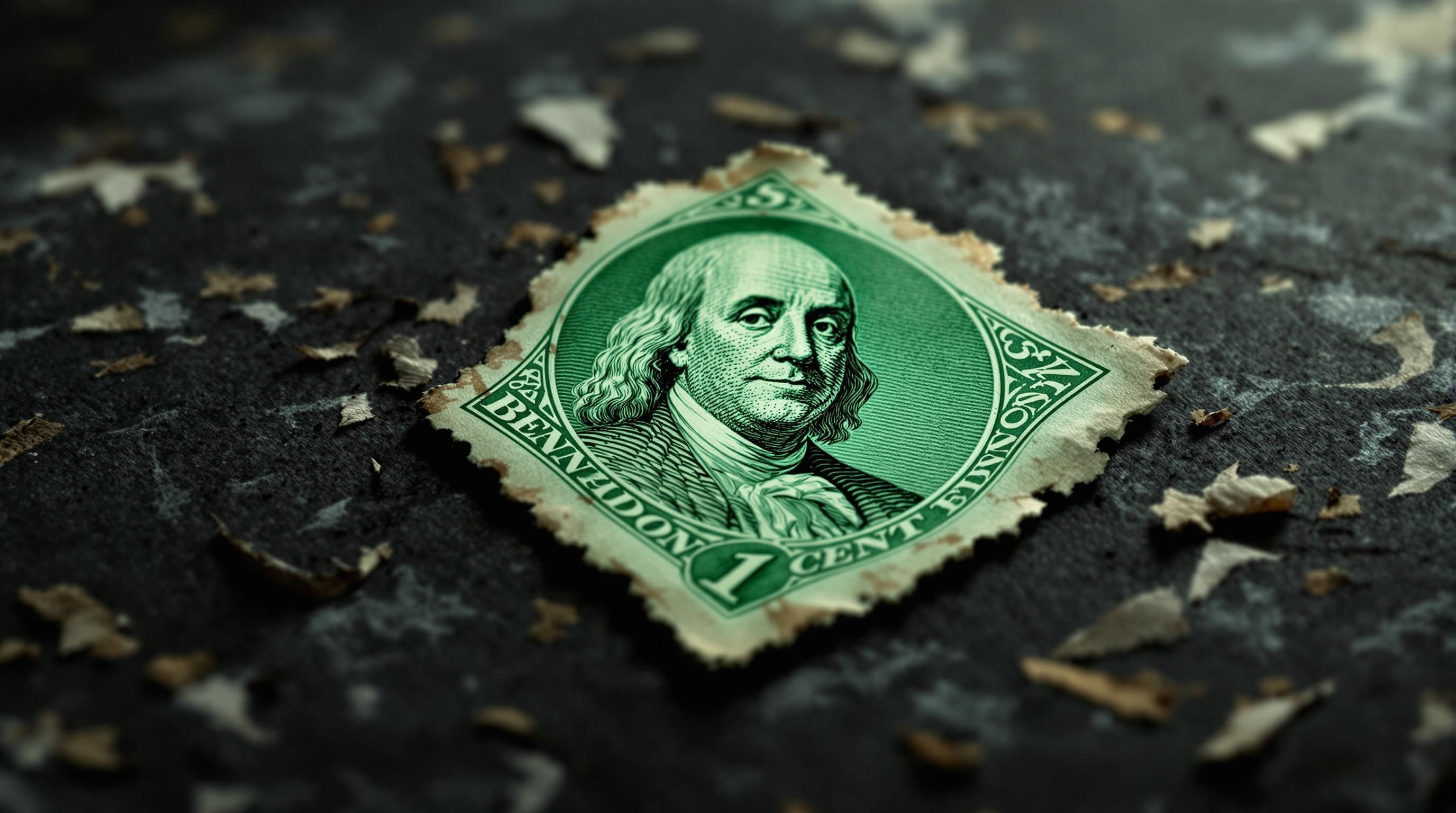Introduction to Benjamin Franklin Stamps
Benjamin Franklin, America’s founding father and first Postmaster General, has been honored on more U.S. postage stamps than any figure except George Washington. The 1-cent Franklin stamp is particularly iconic, with numerous varieties produced over decades. While most 1-cent Franklin stamps are common and worth only a few dollars or less, certain rare varieties can command thousands of dollars at auction.
This guide will help you understand which 1-cent Benjamin Franklin stamps are truly valuable, how to identify them, and their current market values. We’ll explore the most sought-after varieties and explain why some seemingly ordinary stamps can be worth a fortune while others are worth mere pocket change.
Understanding Benjamin Franklin Stamp History
Evolution of 1-Cent Benjamin Franklin Stamps
- 1847
First U.S. Postage Stamps
The first U.S. postage stamps featured Benjamin Franklin (5-cent) and George Washington (10-cent). These early Franklin stamps are extremely valuable. - 1867-1868
Z Grill Issue
The rarest Benjamin Franklin stamp is the 1-cent Z grill (Scott #85A), with only two known copies in existence. One sold for $935,000 in 1998. - 1902-1908
Second Bureau Issues
The 1-cent Franklin stamps from this period featured a redesigned portrait. Some varieties from this era can be quite valuable. - 1912-1914
Washington-Franklin Issues
Benjamin Franklin appeared on the 1-cent denomination in the Washington-Franklin series with various perforations and watermarks creating valuable varieties. - 1923
Rotary Press Rarities
The 1¢ green Franklin stamps printed by rotary press and perforated 11 (Scott #594 and #596) are among the most valuable 20th-century U.S. stamps.
Over four billion 1-cent green Franklin stamps were printed, making most varieties extremely common. However, production methods, printing errors, and limited distribution created several rare varieties that command premium prices today.
The Most Valuable 1-Cent Benjamin Franklin Stamps
The 1-Cent Z Grill (Scott #85A)
The rarest and most valuable Benjamin Franklin stamp is the 1-cent Z grill issued in 1867-1868. With only two known copies in existence, this stamp is considered the holy grail of American philately. One copy resides in the collection of the New York Public Library, while the other was famously traded in a $3 million deal for the unique “Inverted Jenny” plate block.
Scott #594: The 1923 Rotary Press Rarity
The 1¢ green Franklin rotary press stamp perforated 11 (Scott #594) is one of the most valuable 20th-century U.S. stamps, with an estimated value of $10,000 or more in fine condition. Only around 100 examples are known to exist.
Scott #596: The 1923-1924 Perforated 11 Variety
Similar to the #594, the Scott #596 is another rotary press variety perforated 11, with only slightly more examples known. Its current value ranges from $5,000 to $10,000 depending on condition.
Valuable 1-Cent Benjamin Franklin Stamp Varieties
Current market values for rare Benjamin Franklin 1-cent stamps
</tbody>
</table>
How to Identify Valuable Benjamin Franklin Stamps
Key Identification Factors
Perforations: Count the number of perforations within a 2cm space. The rare Scott #594 and #596 are perforated 11, while most common varieties are perforated 10 or 11 x 10.5.
Printing Method: Determine if the stamp was printed by flat plate or rotary press. Rotary press stamps are slightly larger in one dimension due to paper stretching during printing.
Watermarks: Hold the stamp up to light or use watermark fluid to check for watermarks. Different watermarks can significantly affect value.
Grills: Some early Franklin stamps have embossed patterns called “grills” that can be seen on the back. The Z grill and F grill varieties are particularly valuable.
Production Year: Verify the issue date by checking catalog references. Stamps from certain years are more likely to be valuable varieties.
Valuable 1-Cent Franklin Stamp Identification Checklist
Use this checklist to help identify potentially valuable 1-cent Benjamin Franklin stamps
- Stamp appears slightly larger in one dimension than common issues
- Perforations measure exactly 11 per 2cm on all sides
- Paper has no watermark (for Scott #594 and #596)
- Stamp has rich, deep green color rather than pale green
- Print date is from 1923-1924 era
- Visible grill pattern can be seen on the back of the stamp (for early issues)
- Stamp shows evidence of being from a coil (trimmed sides or paste-up)
Benjamin Franklin Stamp Market Statistics

Common vs. Rare: Debunking Stamp Value Myths
The vast majority of 1-cent Benjamin Franklin stamps are extremely common and worth less than $1 each. According to the American Philatelic Society, over 95% of stamps ever printed are worth a dollar or less, with most 1-cent Franklin stamps falling into this category.
Common Misconceptions
Myth 1: All old stamps are valuable Reality: Age alone doesn’t determine value. Many stamps from the early 1900s were printed in quantities of billions and remain common today.
Myth 2: eBay listings prove high values Reality: Many sellers list common stamps at inflated prices, hoping to catch uninformed buyers. Check sold prices instead of asking prices.
Myth 3: Green 1-cent Franklin stamps are all rare Reality: Most green Franklin stamps are worth only face value or slightly more. Only specific varieties with distinct printing characteristics have significant value.
As stamp expert and YouTube educator Graham Beck explains, many common Franklin stamps are falsely listed online for thousands of dollars, creating confusion about their true worth.
Recent Auction Sales: Rare 1-Cent Benjamin Franklin Stamps
Notable auction results for genuinely rare 1-cent Franklin varieties
| Category | Price | Notes |
|---|---|---|
| 1-Cent Z Grill (Scott #85A) | $935,000+ | Extremely rare with only 2 known examples |
| 1923 Rotary Press (Scott #594) | $10,000-$50,000 | ~100 examples known, most with flaws |
| 1923-24 Rotary Perf 11 (Scott #596) | $5,000-$10,000 | Scarce with ~200 examples known |
| 1868 F Grill (Scott #92) | $800-$3,000 | Value depends heavily on condition |
| 1908 Coil (Scott #316) | $3,500-$7,500 | Early experimental coil stamp |
</tbody>
</table>

Condition's Impact on Benjamin Franklin Stamp Values
Condition Factors Affecting Value
Centering: Perfectly centered stamps can sell for 2-5 times more than off-center examples of the same stamp.
Gum Condition: For unused stamps, original undisturbed gum (never hinged) commands a premium over hinged or regummed examples.
Perforations: Complete, undamaged perforations are essential for maximum value.
Cancellations: For used stamps, light or interesting cancellations are preferred over heavy or messy ones.
Color: Fresh, vibrant colors are worth more than faded examples.
According to Linn’s Stamp News, a well-centered Scott #594 with original gum can sell for more than twice the value of an off-center example in otherwise similar condition.
Condition Impact on 1-Cent Franklin Stamp Values
How condition affects the value of Scott #594 (1923 Rotary Press Perf 11)
| Item | Price | Date | Auction House |
|---|---|---|---|
| Scott #594 (1923 Rotary Perf 11) | $9,950 | January 2023 | Mystic Stamp Company |
| Scott #596 (1923-24 Rotary Perf 11) | $6,750 | March 2023 | Robert A. Siegel Auction |
| Scott #316 (1908 Coil) | $3,500 | May 2023 | Heritage Auctions |
| 1912 Ben Franklin (Standard Issue) | $699 | June 2023 | eBay |
</tbody>
</table>
Expert Authentication: When to Get Your Stamp Verified
Why Authentication Matters
The difference between a common 1-cent stamp worth $0.50 and a rare variety worth thousands often comes down to subtle characteristics that only experts can verify with certainty. Without proper certification, most dealers and auction houses won’t accept claims of rare varieties.
Reputable Authentication Services
The Philatelic Foundation: America’s oldest and most respected stamp authentication service.
American Philatelic Society’s Expertizing Service (APEX): Offers authentication services with certificates recognized throughout the industry.
Professional Stamp Experts (PSE): Known for their detailed grading system and expertise in U.S. stamps.
According to the American Philatelic Society, authentication typically costs $20-$50 for most stamps, with fees increasing for items of higher value. For potentially valuable Franklin stamps like Scott #594, this investment is essential to establish authenticity and maximize value.
Expert Authentication Resources
The Philatelic Foundation
America's premier stamp authentication service, offering certificates of authenticity for rare stamps including Benjamin Franklin issues.
American Philatelic Society (APEX)
Authentication service from America's largest stamp collecting organization, with extensive expertise in U.S. issues.
Professional Stamp Experts (PSE)
Offering detailed grading and authentication with particular expertise in 20th-century U.S. stamps.
Where to Buy and Sell Rare Benjamin Franklin Stamps
Best Places to Buy Rare Franklin Stamps
Specialized Auction Houses: Companies like Robert A. Siegel Auction Galleries and H.R. Harmer regularly feature rare U.S. stamps with proper authentication.
Reputable Stamp Dealers: Established dealers who are members of the American Stamp Dealers Association (ASDA) or American Philatelic Society (APS) often have rare stamps in inventory.
Major Stamp Shows: Events like WESTPEX, NAPEX, and StampShow bring together dealers with high-quality inventory and often feature on-site expertizing.
Selling Valuable Franklin Stamps
Consignment to Auction Houses: For genuinely rare and valuable varieties, specialized philatelic auction houses typically offer the best returns.
Direct Sale to Dealers: Established stamp dealers may offer immediate payment, though typically at wholesale prices.
Online Marketplaces: Platforms like eBay can work for authenticated stamps, but beware of uninformed buyers who may be skeptical of high-value claims without proper certification.
According to Linn’s Stamp News, public auctions tend to realize 10-30% higher prices than private sales for rare stamps, making them the preferred option for selling valuable Benjamin Franklin varieties.
Common Questions About Rare 1-Cent Benjamin Franklin Stamps
Are Franklin 1 cent stamps worth anything?
What is the rarest Benjamin Franklin stamp?
How do I know if my 1 cent stamp is valuable?
To determine if your 1-cent Benjamin Franklin stamp is valuable:
- Check the perforations - rare varieties like Scott #594 have exactly 11 perforations per 2cm on all sides
- Examine the printing method - rotary press stamps appear slightly larger in one dimension
- Look for watermarks by holding the stamp up to light or using watermark fluid
- Check for grills (embossed patterns) visible on the back of early issues
- Verify the issue date using a stamp catalog
- Assess the condition - well-centered stamps with undamaged perforations are worth more
For potentially valuable stamps, get professional authentication from services like the Philatelic Foundation or the American Philatelic Society’s expertizing service (APEX).
What makes the Scott #594 1-cent Franklin stamp so valuable?
The Scott #594 1-cent Franklin stamp is valuable due to its extreme scarcity and unique production characteristics. It was printed by rotary press but perforated 11, a combination only used briefly in 1923. Most rotary press stamps were perforated 10 or 11 x 10.5.
Only about 100 examples are known to exist, most discovered after being used on mail. The stamps weren’t recognized as rare until after most were used, making unused examples particularly valuable. Additionally, the rotary printing method made the stamps slightly larger than their flat plate counterparts, creating a distinctive variety sought by collectors.
A well-preserved Scott #594 can sell for $10,000-$50,000 depending on condition, with perfectly centered examples commanding even higher prices.
How much is a 1906 Benjamin Franklin 1 cent stamp worth?
A 1906 Benjamin Franklin 1-cent stamp (Scott #300) from the Second Bureau Issue is generally worth:
- Used: $0.20-$1.00
- Unused with hinged gum: $10-$25
- Mint never hinged: $30-$75
Values increase significantly for well-centered examples or specialized varieties like coils. The 1908 experimental coil version (Scott #316) is much rarer and can be worth $3,500-$7,500.
The most important factors affecting value are centering, gum condition (for unused stamps), and overall freshness. For any potentially valuable stamp, condition is critical in determining its worth.
Conclusion: Navigating the World of Rare Franklin Stamps
The allure of finding a rare stamp worth thousands of dollars in a common collection continues to inspire stamp collectors. While the odds of discovering a Scott #594 or Z grill in your grandmother’s album are slim, understanding what makes these stamps valuable enhances appreciation for all philatelic material.
For collectors interested in Benjamin Franklin stamps, consider these final recommendations:
Start with Education: Invest in reference catalogs and guides before spending money on potentially rare stamps.
Focus on Condition: Even common Franklin stamps in superb condition can command premium prices.
Seek Authentication: For any potentially valuable variety, professional certification is essential.
Join Collector Communities: Organizations like the American Philatelic Society offer resources and expertise to help navigate complexities.
Collect for Enjoyment: While valuable stamps are exciting, the historical significance and beauty of all Benjamin Franklin issues make them rewarding to collect regardless of monetary value.
External Resources
American Philatelic Society
America's largest nonprofit organization for stamp collectors, offering education, authentication services, and collector community.
Scott Specialized Catalogue of United States Stamps
The definitive reference guide for U.S. stamps, including detailed listings of all Benjamin Franklin issues with current values.
Linn's Stamp News: Franklin Stamp Identification
Detailed guide to identifying rare 1-cent Franklin varieties like Scott #594 and #596.
Smithsonian National Postal Museum
Home to world-class philatelic collections including rare Benjamin Franklin stamps and educational resources.
Mystic Stamp Company: 1-Cent Franklin Stamps
Respected stamp dealer offering Benjamin Franklin stamps for sale with educational information about various issues.
YouTube: This Franklin Stamp Is Worth $0
Educational video debunking myths about common 1-cent Franklin stamps often falsely advertised as rare.
Get a Professional Appraisal
Unsure about your item’s value? Our certified experts provide fast, written appraisals you can trust.
- Expert report with photos and comps
- Fast turnaround
- Fixed, upfront pricing
No obligation. Secure upload.
| Category | Price | Notes |
|---|---|---|
| Superb (Perfect centering, NH gum) | $50,000+ | Extremely rare in this condition |
| Very Fine (Well-centered) | $10,000-$15,000 | Standard quality for serious collectors |
| Fine (Slightly off-center) | $5,000-$7,500 | Most common condition |
| Average (Off-center or flaws) | $2,500-$4,000 | Still valuable due to rarity |
| Poor (Heavy cancellation, tears) | $1,000-$2,000 | Value comes from rarity alone |




